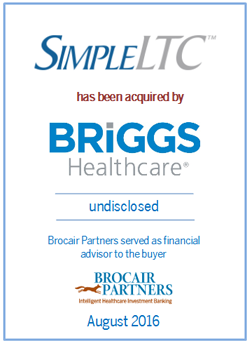Brocair Partners LLC, an investment bank serving the healthcare industry, advised Briggs Healthcare in its acquisition of data analytics provider SimpleLTC
NEW YORK, NY – August 23, 2016 – Brocair Partners LLC, an investment banking firm serving the healthcare industry, advised Briggs Healthcare, a leading provider of products and services to the senior care, home care, acute care, physician and retail markets, on its acquisition of SimpleLTC Systems, Inc.
Founded in 2003, SimpleLTC offers software products that help long-term care providers simplify data management and analytics, automate manual processes, and comply with regulatory requirements. Over the past three years, SimpleLTC, based in Richardson, Texas, has launched a suite of new analytics tools allowing providers to use predictive intelligence in order to improve quality measures, reduce rehospitalizations, and optimize reimbursement.
The transaction size was not disclosed.
Briggs Healthcare has a long history of delivering documentation tools which support regulatory compliance and quality outcomes in the long-term care and home care industries. With the addition of SimpleLTC, its customers will have the ability to use the data they collect to gain insight to improve their day to day operations, and provide a higher quality of care.
Gregg Blake, Managing Partner of Brocair, explained, “Briggs has deep experience in the long-term care and home health markets, and its products are the standard of care for documentation of patient encounters. But with greater demands for the measurement of the quality of care, Briggs needed to expand its data analytics offerings to provide additional tools for its customers. This acquisition represents an important transformative step for the firm, allowing Briggs to enter the downstream data utilization space and to provide a more complete package of services to its extensive customer base.”
Bruce Dan, CEO of Briggs Healthcare, remarked “Brocair’s professional and experienced team was instrumental in proactively identifying SimpleLTC as the ideal acquisition for our digital expansion plans. Their industry knowledge and patience was a critical part of the acquisition process of introduction, data collection, and close. We have worked with Gregg and his team for several years and look forward to future M&A successes as well.”

About Briggs Healthcare:
For more than 65 years, Briggs Healthcare has been a leading provider of products and services to the senior care, home care, acute care, physician and retail markets. Headquartered in West Des Moines, IA, Briggs Healthcare serves more than 50,000 customers globally with affiliate operations in Waukegan, Illinois, Moorestown, New Jersey, Waco, Texas, and the United Kingdom. Backed by clinical experience and regulatory knowledge, the company develops and markets products that are designed to improve clinical outcomes and reduce operating costs, including proprietary documentation systems, medical record charting, medical supplies and rehabilitation aids, staff education and resource materials and obstetric products. Visit Briggs online at www.BriggsCorp.com.
About SimpleLTC:
SimpleLTC creates software that simplifies regulatory compliance, reimbursement optimization and quality measurement for long-term care. Specialties include predictive MDS and quality measures analytics, MDS transmission and reporting, and Texas Medicaid reimbursement analytics. More than 2,500 long-term care providers now use SimpleLTC products. For more information: www.simpleltc.com.
About Brocair Partners LLC:
Brocair Partners, founded in 2004, provides financial advice to businesses serving the healthcare, wellness, and pharmaceutical industries. We provide mergers & acquisitions, corporate finance, and strategic advisory services to companies worldwide. This transaction and other Brocair transactions can be found here: www.brocair.com


